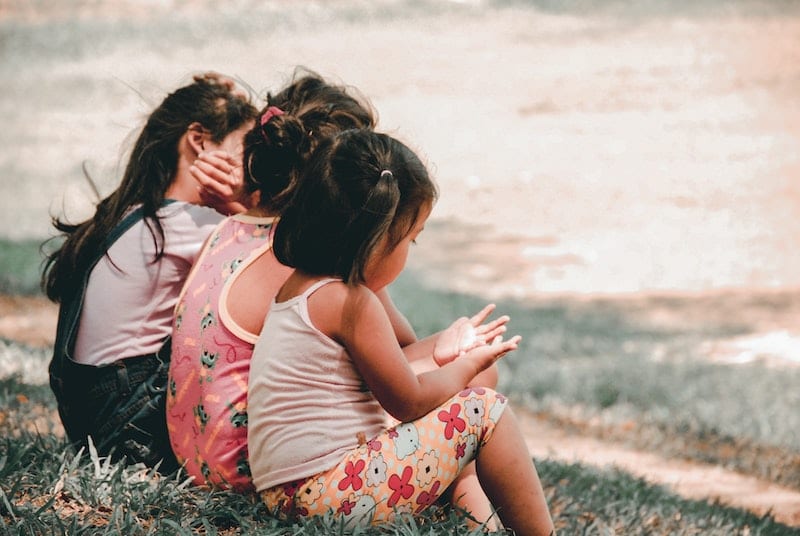Why is meditation for children important? How do I begin? Here’s a guided meditation script for parents and caregivers to follow.

Getting a child to sit still and be silent for even five minutes might feel like an impossible task but research is revealing that meditation can have immense benefits on developing brains. All this evidence makes it more important to start learning about meditation for children.
Scroll down to the bottom for quick access to the meditation script
In many places in the world, this idea of encouraging children to meditate is being promoted. Schools in places like India and Burma have been doing this for centuries and now we are seeing the Western world follow suit.
Here’s how meditation for children can help
1. One significant benefit of guided meditation for children is improved focus and attention. This is a big plus for anyone that practices meditation but especially for children of school age when the ability to focus is essential. With all the technological distractions children now have, research shows a child’s ability to remain focused on one task is even less than before.
2. Meditation helps improve our ability to cope with stress, anxiety and difficult situations or events. A child who learns meditation will start to understand how to calm their mental and physiological responses before they even really understand why they need to do this. It will become natural for them to recognize the difference between a relaxed state and a state of stress or tension.
3. Improved self-control: Of course we have to take this with a pinch of salt; they are children after all. You can get them counselled for self-control. But by cultivating a practice that involves pausing and learning how to accept the thoughts and emotion that arise rather than instantly reacting, they’ll be able to train the brain to develop more discipline and patience.
Do’s and Don’ts

If you want to introduce guided meditation for children into your daily family life, you need to make it as age appropriate as possible. You also need to make sure it is a positive experience for your child. Here are a few do’s and don’ts to consider.
Do’s
- Use a visualisation tool. This helps the child focus. Consider encouraging them to think of a colour or scenery/ or happy place.
- Use simple breathing exercises as a form of meditation
- Repetition of the same instructions can be helpful. i.e. if the meditation is around the breath, keep reminding them to feel the breath come in through the nose and out through the nose.
- Be patient with it and remember it takes time and does not come naturally to all children. Just simply learning how to sit still for one minute might be a good place to build from.
- You might choose to use aids like meditation stories for children to help them develop the ability to sit still and calm their minds. Alternatively you could introduce pre-bedtime guided sleep meditation for children so they associate it with quiet time.
Dont’s
- Use overly complicated instructions or language.
- Leave periods of silence for more than a few counts.
- Get annoyed if they start moving or getting up.
- Be too serious (remember meditation doesn’t need to be serious and is not something that you want your child to associate negative feelings with, be light hearted with it).
Here’s a script for meditation for children:
You may like to start with this script. First, find a quiet space to sit with the child and read this script out loud. It begins with a simple breathing meditation for children. This will help teach a child how to slow their breath and calm their nervous system. It also uses a visual colour to help with the focus.
- Lets start by sitting down.
- Putting our hands on our belly and taking a big breath into the belly. Filling it all the way up as much as we can and then opening the mouth and taking a big breath out. Repeat three times.
- Now all I want you to do is close your eyes and listen to my voice
- In your belly, I want you to imagine a balloon. This balloon is your favourite colour. Picture the balloon in your belly and it’s your favourite colour. Every time you breathe in, imagine that you are filling up the balloon with air and you can see the balloon getting bigger. When you breathe out, you’re slowly letting the air out of the balloon and it gets smaller and smaller.
- Keep imagining the balloon. Breathing in and filling it up and breathing out and emptying it.
- Do this as slow as you can, very slowly breathing in and filling up the balloon, very slowly breathing out, exhaling and emptying the balloon.
- Keep breathing, deep breath in and deep breath out. Filling up that balloon and then emptying it. (Note to parent: Don’t forget to offer praise to the child, ‘that’s really good. Keep breathing like that.’)
- We’ll do this together three more times, breathe in fill the balloon, breath out empty the balloon (repeat twice more).
- Now as you exhale, breathing all the way out, let go of the image of the balloon and bring your attention back to you and me sitting in this room, on this floor
- Picture it in your head, take a big smile and then slowly blink open your eyes.



